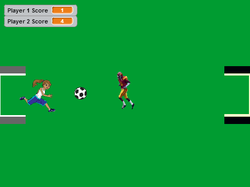
In the past two weeks I have extended on what I have learnt through tutorials and challenges during my first three weeks of learning Scratch by embarking on an individual project. I decided that I would attempt to create a virtual soccer game using Scratch. The end product can be accessed here.
To begin with I used a combination of what I learnt while making the racing game and the Pong like game to create the background, sprites (the players and the ball) and player scores. I encountered a challenge early on, I could not get one of the players to face to opposite way when it was moved. Eventually I found the button that allowed me to do this, but it did take some time. The next time consuming component was experimenting to find the best directions for the characters to move in. To begin with I had the characters moving on angles rather than up and down but this ended up proving too awkward during game play.
When it came to setting the sequences for the ball I ended up struggling more than I expected to. I could not work out how to keep the ball with the player. Eventually I used Google to find Scratch ball game tutorials. I found a similar game where I saw they created a direction variable, I used this information in my own project and found it worked very well.
During this activity I learnt that while something may seem reasonable simple during the planning process it is often the minor details that can be the most difficult to perfect. I have also learnt the value of sharing Scratch projects and tutorials as it can provide that little bit of needed assistance when it is really needed.
This has many potential applications in the primary school classroom. A good Scratch project for an upper primary school classroom should require higher order thinking and encourage creativity. For the years 5 and 6 a Scratch project would fall under the band descriptors, 'Follow, modify and describe simple algorithms involving sequence of steps, decisions, and repetitions that are represented diagrammatically and in plain English' and 'Design and implement digital solutions using visual programs with user input, branching and iteration' (Australian Curriculum, Assessment and Reporting Authority, 2013). The first Scratch project/challenge given to students may be to modify an existing project for a specific purpose. As students develop confidence with Scratch they may then embark on individual or group projects where the teacher might either discuss ideas with each group or give the students a basic criteria while still allowing for creativity.
To begin with I used a combination of what I learnt while making the racing game and the Pong like game to create the background, sprites (the players and the ball) and player scores. I encountered a challenge early on, I could not get one of the players to face to opposite way when it was moved. Eventually I found the button that allowed me to do this, but it did take some time. The next time consuming component was experimenting to find the best directions for the characters to move in. To begin with I had the characters moving on angles rather than up and down but this ended up proving too awkward during game play.
When it came to setting the sequences for the ball I ended up struggling more than I expected to. I could not work out how to keep the ball with the player. Eventually I used Google to find Scratch ball game tutorials. I found a similar game where I saw they created a direction variable, I used this information in my own project and found it worked very well.
During this activity I learnt that while something may seem reasonable simple during the planning process it is often the minor details that can be the most difficult to perfect. I have also learnt the value of sharing Scratch projects and tutorials as it can provide that little bit of needed assistance when it is really needed.
This has many potential applications in the primary school classroom. A good Scratch project for an upper primary school classroom should require higher order thinking and encourage creativity. For the years 5 and 6 a Scratch project would fall under the band descriptors, 'Follow, modify and describe simple algorithms involving sequence of steps, decisions, and repetitions that are represented diagrammatically and in plain English' and 'Design and implement digital solutions using visual programs with user input, branching and iteration' (Australian Curriculum, Assessment and Reporting Authority, 2013). The first Scratch project/challenge given to students may be to modify an existing project for a specific purpose. As students develop confidence with Scratch they may then embark on individual or group projects where the teacher might either discuss ideas with each group or give the students a basic criteria while still allowing for creativity.
 RSS Feed
RSS Feed